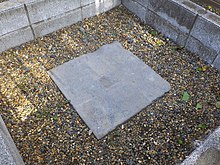Empuku-ji (Chōshi)
The Empuku-ji ( Japanese 圓 福寺 ), also called Iinuma Kannon ( 飯 沼 観 音 ) with the mountain name Iinuma-san ( 飯 沼 山 ), is an old temple that belongs to the Shingon school of Buddhism. It is in Choshi in Chiba Prefecture , Japan, and is the 27th temple of 33 Kannon Temple of the Kanto area .
history
According to the tradition of the temple, the statue of an eleven-headed Kannon was pulled ashore in the net in 728 , for which a grass-covered hut ( 草堂 sōdō ) was built. In the Middle Ages, the place of prayer was supported by the ruling family of the area, the Unakami ( 海上 氏 -shi ). In the Edo period , many pilgrims came here from the coastal towns of Iinuma and Matsugishi, so that Chōshi developed into a place of pilgrimage.
During the Pacific War anti-aircraft guns were set up in Chōshi, which led to the bombing of the place by the Americans. The temple was largely destroyed.
The attachment
You enter the temple in the west through the temple gate, which is designed here as a two-story tower gate ( 楼門 Rōmon ; 1 in the plan). To the right and left of it, the two temple guards ( 仁王 Niō ) protect the passage. Today's goal replaced the lost goal in 1972. Ahead you can see the main hall ( 本 堂 Hondō ; 2). It stands on a high foundation and can be reached by stairs. Kannon, who is worshiped there, is generally not to be seen. The present building dates from the period after 1945. On the way you pass on the right side of the bell tower ( 鐘楼 Shoro ; 3) and then to the left of the "Big Buddha" ( 大仏 Daibutsu ; 4). This seated Amida Buddha dates from 1711, is made of bronze and about 5.4 m high. Traces of the air raids can be seen on it. Behind it on the left is the 33.55 m high five-story pagoda ( 五 重 塔 Gojū-no-tō ; 5) from 2009.
A special feature on the temple grounds behind the pagoda is the height zero mark (N in the map) from 1872. It was created by the Dutch surveyor Isaac Lindo (1848–1941) and was the starting point for height measurements in Japan.
Behind the main hall, separated by a street, there are other buildings of the temple. There is the hall dedicated to the temple founder, the Daishidō ( 大師 堂 ; 6) from 1847. Next to it is the temple's treasure house ( 宝物 殿 Hōmotsu-den ; 7), in which the temple treasures are kept.
The Chōkō Shrine ( 銚 港 神社 Chōkō-jinja ; S) extends into the temple grounds .
Temple treasures
- Nyō ( 鐃 ), a bell as a Buddhist cult device, is registered as an important cultural asset of Japan . It is kept in the Nara National Museum.
- A temple bell ( 梵 鐘 Bonshō ) from 1462 (Kyōtoku 11) and a three-part representation of the Buddha on the death bed ( 釈 迦涅 槃 図Shaka nehan-zu ) and a three-volume description of the origin of the image ( 釈 迦涅 槃 図 由来 書 Shaka nehan-zu yuraisho ) are registered as Important Cultural Property of Chiba Prefecture.
Remarks
- ↑ In 1890 a zero mark, the Tokyo Peil, was set up in Tokyo .
literature
- Chiba-ken kotogakko Kyoiku kenkyukai rekishi bukai (Ed.): Empuku-ji . In: Chiba-ken no rekishi sampo. Yamakawa Shuppan, 2006. ISBN 978-4-634-24612-6 . Pp. 188, 189.
Web links
Coordinates: 35 ° 43 ′ 55 " N , 140 ° 50 ′ 26.2" E



